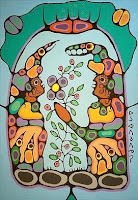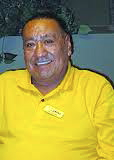The shaking tent is a ceremony widespread among indigenous peoples of North America, during which a shaman is tightly bound within a darkened lodge, the structure shakes violently, and the shaman — and sometimes the audience as well — converses with spirits who speak and sing, and sometimes appear in various forms, such as darting blue lights. When light is restored, the shaman is revealed to be unbound and sitting comfortably, apparently untied by the spirits.
 |
| Norval Morrisseau, Shaking Tent |
The picture at right, by famed Ojibwa painter Norval Morrisseau, depicts a shaking tent ceremony — the healer and patient seated within the lodge, which is being shaken, at its top, by the immense powers of the spirit world invoked by the healer.
Among the Lakota, the shaking tent ceremony is called a yuwipi. As elsewhere, the healer is tied up with ropes or leather thongs and a special blanket — wicahpi šina, star quilt — while praying for the healing of a specific person or persons. The term yuwipi is usually derived from the Lakota verb form they wrap him up. The healer is called yuwipi wicaša, yuwipi man, who gives away a piece of his life every time he performs the exhausting ceremony, in order to serve the people.
The yuwipi man mediates between the people and the spirit world. He is a wicaša wakan, a sacred person, who is not only a healer, but whose counsel is sought for family and business matters. He understands the languages of all creatures and can communicate directly with the spirits, who tell him how a patient’s sickness may be cured. The Lakota distinguish between white sickness, which can be cured by biomedical intervention, and Indian sickness, which is the result of disharmony between humans and the spirit world. The yuwipi man is the sole healer of Indian sickness.
During the ceremony, a helper holds the sacred pipe, and people around the perimeter of the room also pray for the healing. While the spirits are present, people other than the patient may also make their requests known to the spirits, addressed as tunkašila, grandfather, through the medium of the yuwipi man, who acts as the ieska, interpreter. A detailed description of a yuwipi ceremony is here.
 |
| Gary Holy Bull, yuwipi man |
Ringing Rocks Foundation in Sedona, Arizona, is dedicated to conserving indigenous healing practices and cultural traditions. The foundation supports ethnographic fieldwork, public education, and the active promotion of indigenous cultures. The foundation’s seminal work is a book series, Profiles of Healing, which collects first-person narratives from some of the world’s most respected indigenous shamans, healers, and medicine keepers. The project was founded by the remarkable Bradford Keeney, author of more than thirty books in the fields of psychotherapy, cybernetics, and indigenous healing traditions, many of them considered to be classics. The first volume in the series is a profile of the life and teachings of Gary Holy Bull, a widely respected Lakota yuwipi man.
Cultural Survival is the leading US-based organization defending the rights of indigenous peoples around the world. It was founded in response to the opening up of remote Amazonian and South American areas during the 1960s, and the drastic effects this had on indigenous inhabitants. It has since worked with indigenous communities in Asia, Africa, South America, North America, and Australia, guided by a board of directors that includes not only anthropologists, philanthropists, and entrepreneurs but also prominent indigenous leaders.
 |
| Gary Holy Bull gathering sage |
One Cultural Survival program is the Guatemala Radio Project, a five-year partnership with five Guatemalan organizations designed to strengthen a network of 140 community radio stations across the country, many of which broadcast in one or more of the country’s 23 indigenous languages. The stations provide news, educational programming, health information, and traditional music, all reinforcing pride in Mayan heritage.
As part of this project, Cultural Survival joined with the Ringing Rocks Foundation to produce a series of programs in which indigenous spiritual leaders from around the world talk about their practices and traditions. The talks are part of a lecture series sponsored by Ringing Rocks, and the audio portion of the talks is then translated into the four principal Mayan languages and broadcast on the Guatemalan radio stations. The video clips below, by yuwipi man Gary Holy Bull, are from the first of these programs.
The Cultural Survival website — brief registration required — provides Holy Bull’s fascinating first-person account, transcribed from the talk he gave at the Ringing Rocks Foundation, of how he became a healer. Here is a brief excerpt:
Cultural Survival has also made available two video excerpts from that talk, one containing Holy Bull’s advice to young indigenous men, and the other talking about change.I want to tell you how I became a healer. I was a little boy, 10 years old, running around Rocks Side. It was mid-July, a hot summer day, no cloud in the sky. I got tired, so I went inside the house to take a nap. To this day, I’m not sure if I fell asleep and these things happened or if I really did see them. We lived in a log house, a one-room log house, and there was one big log right down the middle, all the way across, which held all the rafters. I sat down on the bed, looking out, and I think I laid down. I saw this lightning come in on both ends of this one log. And that lightning came through, met in the middle, and went down. When it hit the floor I heard this big crack, and when I looked at it, there was a man standing there with a sacred pipe. He stuck the pipe right through the floor into the ground.

- Previous Post: Animated Ayahuasca
- Next Post: El Dorado
- More Articles Related to: Indigenous Culture, Shamanism



What a sweet and calm voice Holy Bull has. Enjoyed the links, especially to Cultural Survivial, which happens to be headquartered in my region.
Nice posting. Thank you for including as an illustration a beautiful Norval Morrisseau’s painiting depicting ‘Shaking Tent Ceremony’ – “It is so embued with Vision!”
Megwetch, SW
Thank you so much for your comment. As you know, I have written about Norval Morrisseau here. Everyone who is interested in the work of this remarkable artist should know about your Norval Morrisseau trading post and blog, both of which provide important information and illustrations of his work. I am delighted to hear from you again.
http://caselaw.findlaw.com/us-8th-circuit/1534515.html
Regarding “U.S. court of appeals,eighth circuit U.S. v. Holy Bull” for abuse of minors & found guilty through own admission & witnesses,(victims), testimonies. Incidents occurred in 1981,’85, & 2007. Trial occurred in 2010. Bull was convicted & sentenced to 87 months.
Thank you for posting this. What a horrible tragedy for the children involved. What a deeply flawed and broken man. The trial court, in imposing sentence, specifically noted that Holy Bull had been “sexually abused by his cousins, and then — God help us — by the nuns․” And, for me, there is also the temptation to point out that shamans are not flawless spiritual masters, but rather, like the rest of us, live in the valley of soul, with sorrow, sickness, regret, and mess. But there is still no excuse for what Holy Bull did, for the trust he shattered, or for the harm he caused.